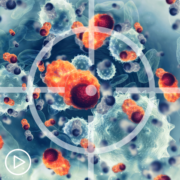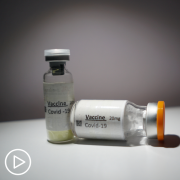Expert Advice for Navigating Non-Small Cell Lung Cancer Care and Treatment from Patient Empowerment Network on Vimeo.
Dr. David Carbone, a lung cancer specialist, discusses factors to consider when choosing treatment for non-small cell lung cancer (NSCLC). Dr. Carbone provides and overview of the type of treatment for NSCLS, why biomarker testing is essential, and shares advices for playing an active role in your care.
Dr. David Carbone is a medical oncologist and professor of internal medicine at The Ohio State University. Dr. Carbone is also co-leader of the Translational Therapeutics Program at the OSUCCC – James, where serves as director of the Thoracic Oncology Center. Learn more about Dr. Carbone, here.
Download Guide
See More From INSIST! Lung Cancer
Related Resources:
Transcript:
Katherine:
Hello, and welcome. I’m Katherine Banwell, your host for today’s program. Today, we’re going to discuss how you can insist on the best care for your non-small cell lung cancer.
Before we get into the discussion, please remember that this program is not a substitute for seeking medical advice.
Please refer to your healthcare team about what might be best for you. All right, let’s meet our guest today. Joining me is Dr. David Carbone. Dr. Carbone, welcome. Would you please introduce yourself?
Dr. Carbone:
Thank you, Katherine. It’s a pleasure to be here. I’m David Carbone. I’m the director of the thoracic oncology center at Ohio State University in Columbus, Ohio. And I have a 35-year clinical and research interest in lung cancer, and I’m a medical oncologist myself.
Katherine:
Excellent, thank you. Thank you for joining us today. Before we get into our discussion, which will focus on non-small cell lung cancer, let’s talk about the types of lung cancer. What is the difference between non-small cell lung cancer and small cell lung cancer?
Dr. Carbone:
Well, I like to tell patients every cancer is different from every other cancer, but they can be broadly categorized in two different categories, small cell and non-small cell.
And this derived from decades ago when small cell lung cancer just looked different under the microscope than non-small cell lung cancer. And different small cells can look different, and now we’re sub-typing small cells. But in general, small cells are treated pretty similarly. Non-small cells are divided into two main groups, the squamous cell carcinomas and the adenocarcinomas.
Adenocarcinomas have a variety of subtypes, as well, and then there are a few of the non-small cell lung cancers that are clearly non-small cell but don’t fit into either of those two categories, and they’re called large-cell or not otherwise specified.
And then, there’s a whole slew of rare types of lung cancers that we probably don’t have time to discuss, and mesothelioma that happened in the chest.
Katherine:
Right. Is one type of lung cancer more common than the other?
Dr. Carbone:
So, the vast majority of lung cancers are the non-small cell lung cancers, about 85 percent. And among the non-small cell lung cancers, most of those are adenocarcinomas or non-squamous. Decades ago, squamous was the most common type, and in some parts of the world, it still is. But in the United States, it depends on the region; 60, 70 percent of lung cancers are adenocarcinomas.
Katherine:
Right, okay, that makes sense. I’d like to pivot and talk about treatment for a couple of moments. What are the current approaches for treating non-small cell lung cancer?
Dr. Carbone:
Well, that’s a complex question. The basic modalities are surgery, which is really still what we prefer, if we can detect it early; radiation therapy; and medical therapy.
And medical therapy can be divided into chemotherapies of some sort – what we call targeted therapies, based on genetic abnormalities in the tumor – and then, immunotherapies to harness the immune system to fight cancer. Those are the three major kinds of therapies.
Katherine:
It seems like patients really do have a lot of options, which is a good thing for them. But how do you then decide which treatment is most appropriate for a given patient?
Dr. Carbone:
Well, it’s not straightforward. When I started 35 years ago, it really wasn’t clear whether any treatment made any difference, and we actually did a large, randomized trial of doing nothing versus treating, and showed that we could improve survival by a month or two with the currently available treatments. Now, we have a huge toolbox of types of treatments and combinations of treatments. And it really requires a careful analysis of the characteristics of the tumor to pick the best therapy.
And specifically, for the adenocarcinomas, the most common type, we now do a detailed genetic analysis on all of the tumors, which can completely change the type of treatment people get and the prognosis, and result in being able to match a pill-type targeted therapy to a particular genetic abnormality with really high efficacy and low toxicity. And there are other markers we use for immunotherapy choices. It’s become quite complicated.
Katherine:
If we’re breaking it down to staging, let’s start with that. What are the stages?
Dr. Carbone:
Right. So, lung cancer, like many cancers, is staged I, II, III, and IV, and of course there’s now As, Bs, and Cs, and subcategories of those. But the basic distinction patients need to know has some utility.
So, the stage I lung cancers, in general, are small tumors that aren’t invading into anything, that haven’t spread anywhere to none of the lymph nodes, to no other structures; and they’re the tumors that we like to find. And they’re the ones whose optimal treatment is surgery, with a good cure rate.
Stage IIs, in general, are those lung cancers that are like stage I, except they involve the nearby lymph nodes in the lung that are called hilar lymph nodes, and those have also a high cure rate, but not quite as so high with surgery; and generally, are treated with surgery followed by chemotherapy, and now, immunotherapy.
Stage III is what we call locally advanced. It’s still only in the chest, but it invades some important structure or has multiple lymph nodes that are deep within the chest. And some of these are surgically resectable, but the majority of stage IIIs, I would say, are not surgically resectable, and are treated generally with chemoradiation, again followed by immunotherapy.
With the stage IV lung cancers, really, that is the lung cancer that’s spread outside the chest; typically, to bones, brain, or liver, or elsewhere in the body.
And that is typically not resectable; though again, there’s exceptions to each of these general rules, and you really need to have that multi-disciplinary evaluation of your cancers to determine the best therapy. But in general, stage IV lung cancers are not surgical candidates, not treated upfront as radiation candidates, and they’re generally treated with medical treatments that go throughout the body, and treat spots of cancer wherever they are.
Katherine:
How about when we look at general health and comorbidities? How do those influence the treatment choices that you would make?
Dr. Carbone:
Every patient is different, like every cancer is different, and we have patients who are 20-year-olds and patients who are 90-year-olds; and patients who’ve taken care of themselves, and those that haven’t done so well taking care of themselves.
More than half of patients, even though they used to smoke, are ex-smokers. And so, they generally are in better condition, but we have to take into account frailty and presence or absence of diabetes, kidney disease, and all those other comorbidities, which are common in lung cancer, which has a median age of onset in the upper-60s, where people have these kinds of comorbidities.
We try not to use age alone as a factor, because there are many robust 90-year-olds, and there are many 50-year-olds on oxygen. So, we have to look at the complete picture to plan the best therapy.
Katherine:
Yeah. What about treatment side effects? How does that bear on what you decide to treat the non-small cell lung cancer?
Dr. Carbone:
Well, unfortunately, we don’t cure most lung cancers. And so, our treatments are designed to prolong life and improve quality of life.
So, we’re very aware of the impact of our treatments on the quality of a patient’s life, and we’ve worked hard, over the years, to improve the risk-benefit ratio of our treatments, so to speak. And again, when I started, we didn’t have good nausea medicines, and people got desperately sick to have a six-week prolongation in survival, and that was really of questionable utility.
But now, even the chemotherapies that we give are generally super-well tolerated. The chemotherapies used in lung cancer are often – people will say, “I feel a little tired for a couple of days, but then, I’m fine,” and they’d often continue to work. Most, I would say, have no nausea; they have no significant side effects; and the immunotherapies, on average, people have very few side effects. They can hardly tell they’re getting the treatment, though sometimes the side effects can be significant.
Like everything I’m telling you, there’s always a spectrum.
Katherine:
Of course.
Dr. Carbone:
And the targeted therapies: Again, most often, people have very mild side effects, with maybe a little skin rash or a slight loose stool, or something. But often, it’s insignificant compare to the magnitude of the benefit they get from these treatments.
Katherine:
Let’s talk about biomarker testing. What is it, first of all, and what are you looking for, exactly, when you receive the results?
Dr. Carbone:
Well, you have to order the results, so you have to know what to order. And we already touched on it a little bit. The genetic analysis of a tumor has become central to picking a therapy. And when I say “genetic analysis,” that is what you’re referring to as one of the biomarker tests we use.
Unfortunately, it’s true that many patients have therapies started without waiting for the results of these biomarker tests, and that really can have a negative impact on their care, because the results of this testing can make the difference between chemotherapy or a pill. It’s a totally diametrically different therapy.
So, these genetic tests look for things that we call driver mutations, and these are alterations in the genes of your cancer that are not present in the rest of your body; they’re not passed down to your children, or need to get looked for in your brother or your sister, like some of the breast cancer mutations you may hear about.
These are mutations that are present in the tumor that act like light switches, and they turn the cancer on to grow like crazy.
And through scientific research, we’ve discovered many of these in lung cancer, where, if we can find the specific driver mutation, many of these have specific drugs that can turn that switch back off. And virtually 100 percent or very close to every patient where we can find that matching drug to their driver will have some tumor shrinkage.
And it’s quite remarkable, but we need to do that matching, because these new drugs only work in that subset of patients with that mutation, and that’s why it’s so important to do that matching. And now, we have eight or 10 of these types of mutations that need to be looked for.
Katherine:
Where do clinical trials fit in, Dr. Carbone?
Dr. Carbone:
Well, I like to say that clinical trials are tomorrow’s standard of care available today, and all of the new treatments that I’m talking about for lung cancer that have made this dramatic difference in survival and quality of life: They’ve all come because of basic science research, understanding how cancers grow, designing drugs, and using them in people in an intelligent way.
Historically, we used to just grind up tree bark or dig things up from the bottom of the sea, and test them in tissue culture to see if they killed cancer cells a little more than normal cells. But today, the treatments we have are based on science, and the success of these treatments is very high compared to what they were historically.
And the way we determine whether a treatment is effective is through something called a clinical trial, where generally the new treatment is compared to the standard treatment.
And if there is no standard treatment, we still do sometimes use placebo-controlled trials, but often that’s placebo plus some chemotherapy, versus the new drug plus that same chemotherapy.
So, it’s really not a placebo-only type situation. But the trials are designed to rigorously test whether the drug improves outcomes, and are an extremely important step in developing these new drugs and finding new things to help patients.
Katherine:
A lung cancer diagnosis often has a certain stigma associated with it, but the majority of that is not based in fact. So, I’d like to play a little game with you called Fact or Fiction. All right? All right, first one. Fact or fiction: Lung cancer is a disease of the older population.
Dr. Carbone:
If you have lungs, you can get lung cancer. That’s it. I’ve seen 20-year-old lung cancer patients. So, I think it can happen to anybody, and unfortunately, things like the CT screening programs are limited to people over the age of 50, but I’ve had many patients in their 30s and 40s. So, if you have lungs, you can have lung cancer.
Katherine:
Okay. Next one, fact or fiction: Quality of life is greatly diminished after undergoing treatment for lung cancer.
Dr. Carbone:
I completely – fiction. I actually tell people often their quality of life is dramatically improved after starting treatments, and that’s my goal.
And with the new treatments, that’s often true. People will tell me within a week that they feel so much better on the treatment than they did before. So, that’s our goal. Our goal is not to make you feel worse. Our goal is to make you feel better.
Katherine:
Of course. All right, last one. Fact or fiction: There are no effective treatments for advanced lung cancer.
Dr. Carbone:
So, the average survival for lung cancer years ago was four to six months from the time of diagnosis to death. That’s bad. And now, we are seeing in these subsets of patients years and years of survival with simple even pill-type treatments or immunotherapies. And even with the immunotherapies, sometimes you get treatments for a year or two, and then we stop; and we have patients who are years later, off of all treatments for metastatic lung cancer, still with no evidence of disease.
So, that is definitely fiction. We have highly-effective treatments for lung cancer. But unfortunately, like everything else, and like I’ve said multiple times, it’s not true for everyone. Our treatments aren’t ideal. Sometimes for a particular patient we can’t find a matching treatment, the standard treatments don’t work, and nothing we can find makes a difference. But I would say you never know that until you try, and for the vast majority of patients, we can definitely give them prolonged, good-quality life. And so, I think that that’s definitely fiction.
Katherine:
Okay, thank you. We have received some questions from audience members earlier on.
And so, David writes, “My care team has suggested immunotherapy to treat my lung cancer. I’m optimistic about the results, but nervous about symptoms and side effects. What can I expect?”
Dr. Carbone:
The immunotherapy is a potent therapy, but you have to understand, you’re dealing with lung cancer, which is a rapidly fatal disease when untreated. So, there’s a balance there. There’s a risk/benefit calculation that happens in picking any treatment.
And it turns out that I would say most lung cancer patients today have immunotherapy as part of their first treatment. Immunotherapy ramps up your own immune system to make it more effective at seeing the cancer, which has previously grown because it’s hidden itself behind a kind of invisibility cloak, and these immunotherapies remove this invisibility cloak so that the immune system can see it.
But at the same time, this process is a normal process that’s used to keep the immune system in check, and keep the immune system from attacking normal tissues, as well. So, it’s pretty common that we see people on immunotherapy have some kind of autoimmune side effect.
The most common side effect with immunotherapy is a skin rash, and usually it’s mild, and you just treat it with a topic corticosteroid, and it’s not a big issue. But it sometimes can be very severe. Like everything else, there’s a spectrum. I would say most patients have no skin problems; some have severe; and it’s almost always treatable. The next most common side effect is thyroid endocrine disorders. So, people will get thyroid function loss. And so, this is something that we follow carefully in the clinic, and people who are on immunotherapy.
And when we start seeing their thyroid levels going down, we just start them on thyroid medication, and that completely fixes that problem. So, but it’s usually permanent, and even after they stop immunotherapy, they’ll need to take thyroid medicines and adjust their thyroid levels.
And then, there’s a whole slew of other possible side effects that are less common. Some are very severe. Less than one percent of patients have a severe side effect called colitis, which causes diarrhea, which can even be life-threatening, but is also treatable if detected early. Very uncommon to be so severe, but patients should let their doctors know if they experience unusual diarrhea.
You can also have inflammation in your lungs called pneumonitis. So, if there’s an onset of shortness of breath, of course, you’ll tell your doctor, and that can be treated, as well. And anything else, there’s a huge list of other things. Arthritis, uveitis, other things that happen, but are pretty rare.
Katherine:
Lindsay sent in this question: “My doctor has talked about putting me on maintenance therapy following my treatment regimen. What is maintenance therapy for lung cancer?”
Dr. Carbone:
So, many of our treatments have a maintenance phase, and I’m not sure which treatment she’s talking about. But even with chemotherapy, now, if people are on chemotherapy alone, will usually use a double chemotherapy to start, and then will drop one of the chemos after a few cycles, and then continue the other as a maintenance.
A more typical regimen today is a combination of two chemos and an immunotherapy. And generally, we’ll stop the more toxic chemotherapy after a few cycles and continue the less toxic chemotherapy plus the immunotherapy, usually for up to two years.
After chemo-radiation, you’d have a maintenance immunotherapy as well. So, maintenance therapy is just a lower-intensity therapy after your initial therapy, designed to keep the cancer from coming back.
Katherine:
Right. Okay. We have one other question, this one from Shelley: “Is lung cancer hereditary? I’m curious if my children should undergo genetic counseling, since I was diagnosed with lung cancer.”
Dr. Carbone:
Well, that’s a simple, complicated question.
So, in general, lung cancer is not hereditary. It’s not like familial breast cancer or ovarian cancer, or those kinds of cancers, or retinoblastoma. Most cases of lung cancer are caused by environmental exposure to cigarette-smoking or radon, and are not passed on to your kids genetically, though there is shared exposure, right?
There are some really rare genetic predispositions that we sometimes find on these biomarker panels.
But the vast, vast majority of lung cancers are not heritable, and you don’t need to worry about your kids, except to tell them not to smoke, and test for radon.
Katherine:
Patients can sometimes feel like they’re bothering their healthcare team with their comments and questions. Why is it important for patients to speak up, and become a partner in their own care?
Dr. Carbone:
So, it’s a fact that when patients get the diagnosis of lung cancer, everything changes in their lives. They suddenly have a whole new vocabulary thrown at them. It’s like their doctor is speaking French to them. They have to trust their life to a person they’ve never met before, and a whole cadre of people coming in and talking to them and poking them and running through scanners.
It’s very difficult for someone whose biggest concern was what to make for dinner that night, and now has a diagnosis of lung cancer, to really comprehend what’s going on. And lung cancer is complicated, so I recommend that patients really try their best to have at least a basic understanding of what’s going on, where their cancer is. I always show the patient their scans.
“Your cancer is here; this is what it looks like; that’s why you’re having that pain over there, because you have this spot here. Your genetic testing shows this and this, and that’s why it’s important, and that’s why we’re using this drug to match this mutation.” And these are things patients will understand if doctors will explain it to them.
And similarly, the side effects. Lung cancer patients tend to be tough people. They’ll say, “It’s not so bad, I feel better; but the side effect is not so bad. I’m just not going to tell them.” And it even happens in clinic that they’ll tell me they feel fine, and then they’ll tell the nurse that they hurt in their left elbow. And I have to go back in and ask them some more questions on that.
So, it’s extremely important to feel comfortable in communicating with your doctor, asking questions; “Why am I getting this scan? Why are we using this treatment? Is this the best treatment? Are there clinical trials available? I have this new symptom, x, y, z,” because symptoms are often much easier to treat when you catch them early than when you catch them late.
And you don’t get a medal for being a tough guy in this situation. Tell your doctor if you have pain, and they can manage it. Tell them if you’re short of breath, and they can help you feel better. They can’t help you if you don’t tell them, and you are your own best advocate in this situation. Ask questions about the treatment, and why that’s the best one for you; and, as I said, about clinical trials.
Katherine:
Excellent. Thank you so much. It’s important for people to remember that.
And I just want to remind our audience that you can send in your questions to question@powerfulpatients.org, and we’ll get them answered, hopefully, on future programs.
So, Dr. Carbone, just to wrap things up, what are you excited about in lung cancer research right now, and what would you like to leave the audience with?
Dr. Carbone:
Well, there’s a lot to be excited about in lung cancer right now. There’s new therapies being approved all the time. We have more new approvals in the last few years than in the last few decades put together. So, there’s a lot to be excited about.
But there’s still a lot of room for improvement, and there are a lot of patients who still suffer and die from lung cancer. So, my message to patients would be to make sure they get their biomarker testing before they start treatment. And it doesn’t mean to get the tests sent off and start on Joe Random treatment, until the test comes back. This means wait until the test comes back before starting treatment.
And then, I would recommend getting second opinions, if a patient is in a private practice without availability of clinical trials, to investigate if there might be new clinical trials available for them; again, before starting treatment, because sometimes even that first dose of standard chemo may make you ineligible for a trial. So, No. 1 is biomarkers.
Katherine:
All right. Thank you so much for joining us today.
Dr. Carbone:
Well, you’re very welcome. Thank you for helping patients better understand how to deal with this disease.
Katherine:
And thank you to all of our partners.
To learn more about lung cancer and to access tools to help you become a proactive patient, visit powerfulpatients.org. I’m Katherine Banwell. Thanks for joining us today.































